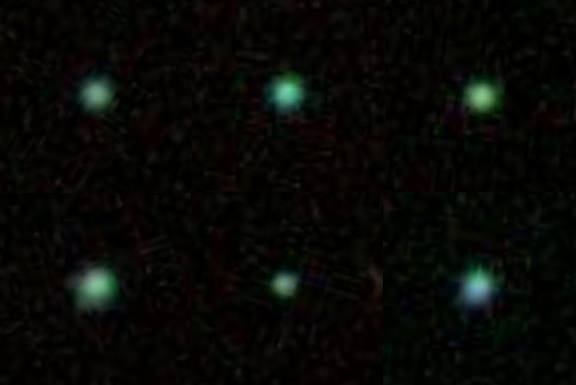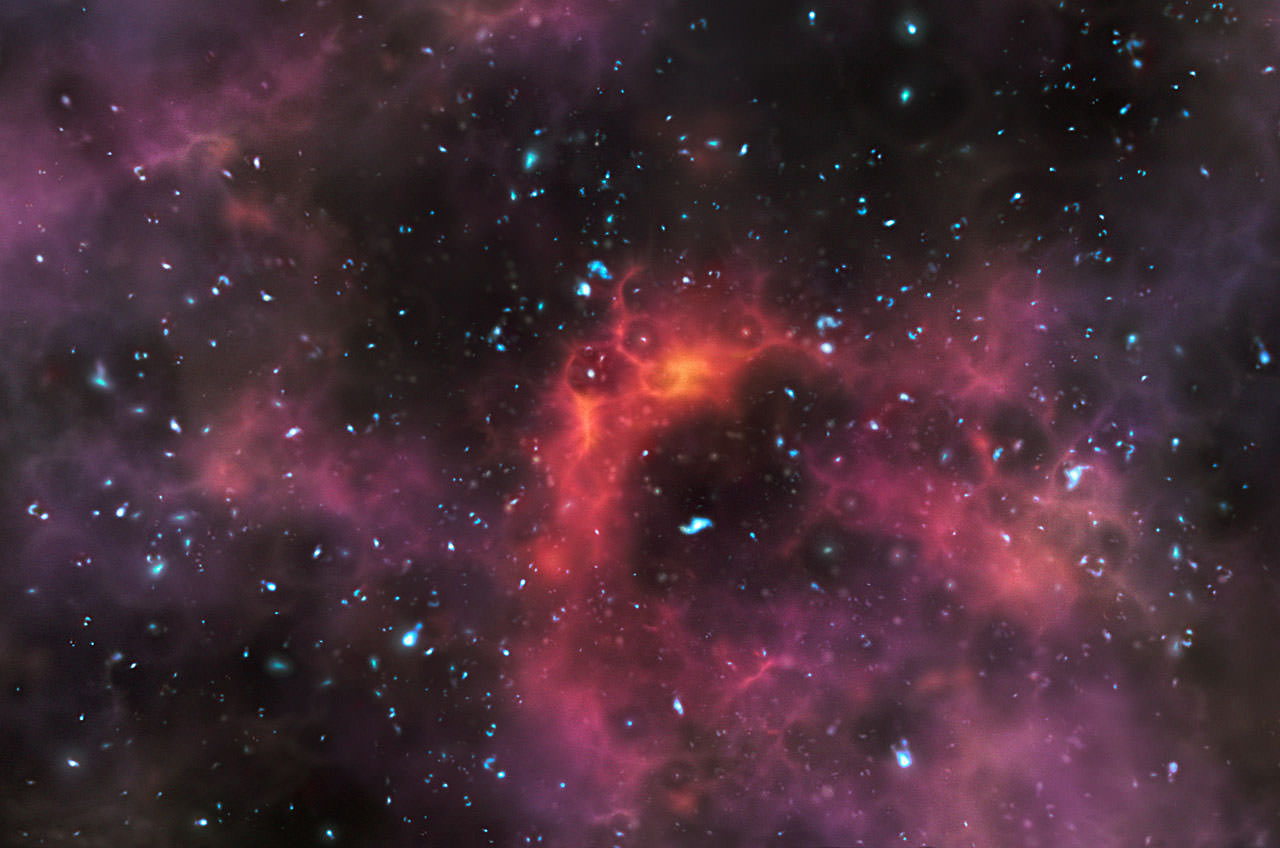After the Big Bang came the Dark Ages, a period lasting hundreds of millions of years when the universe was largely without light. It ended in the epoch of reionization when neutral hydrogen atoms became charged for the first time and the first generation of stars started to form. The question that has perplexed astronomers is what caused the first hydrogen atoms to charge. A team of researchers have observed an early quasar that pumped out enormous amounts of x-ray radiation helping to drive the reionization.
Giant Cluster is Spitting Out Massive Stars

We live inside the Milky Way galaxy which is joined as it drifts through space by two satellite galaxies, the Magellanic Clouds. A star cluster in the Large Magellanic Cloud known as R136 has been the subject of a fascinating discovery. A team of astronomers have discovered 55 high-speed stars that have been ejected from the cluster. The discovery was made using the Gaia satellite and it seems up to a third of stars from the cluster have been ejected in the last century.
Continue reading “Giant Cluster is Spitting Out Massive Stars”Galaxies Regulate their Own Growth so they Don’t Run Out of Star Forming Gas

Look at most spiral or barred spiral galaxies and you will see multiple regions where stars are forming. These star forming regions are comprised of mostly hydrogen gas with a few other elements for good measure. The first galaxies in the Universe had huge supplies of this star forming gas. Left unchecked they could have burned through the gas quickly, generating enormous amounts of star formation. Life fast though and die young for such an energetic burst of star formation would soon fizzle out leaving behind dead and dying stars. In some way it seems, galaxies seem to regulate their star formation thanks to supermassive black holes at their centre.
Continue reading “Galaxies Regulate their Own Growth so they Don’t Run Out of Star Forming Gas”‘Green Peas’ Offer Tiny Clues to Early Universe

Today, we see an unobstructed view of the cosmos in all directions. But, a time existed near the Big Bang when the space between galaxies was an opaque fog where nothing could be seen. And according to two University of Michigan researchers, rare Green Pea galaxies, discovered in 2007, could offer clues into a pivotal step, called reionization, in the Universe’s evolution when space became transparent.
Reionization occurred just a few million years after the Big Bang. During this time, the first stars were beginning to blaze forth and galaxies. Astronomers believe these massive stars blasted the early universe with high-energy ultraviolet light. The UV light interacted with the neutral hydrogen gas it met, scraping off electrons and leaving behind a plasma of negatively charged electrons and positively charged hydrogen ions.
“We think this is what happened but when we looked at galaxies nearby, the high-energy radiation doesn’t appear to make it out. There’s been a push to find some galaxies that show signs of radiation escaping,” Anne Jaskot, a doctoral student in astronomy, says in a press release.
In findings released in the current edition of the Astrophysical Journal, Jaskot and Sally Oey, an associate professor of astronomy, the astronomers focused on six of the most intensely star-forming Green Pea galaxies between one billion and five billion light-years from Earth. The galaxies are compact and closely resemble early galaxies. The objects are thought to be a type of Luminous Blue Compact Galaxy, a type of starburst galaxy where stars are forming at prodigious rates. They were discovered in 2007 by volunteers with the citizen science project Galaxy Zoo. Named “peas” because of their fuzzy green appearance, the galaxies are very small. Scientists estimate that they are no larger than about 16,000 light-years across making them about the size of the Large Magellanic Cloud, a irregular galaxy near our Milky Way Galaxy.
Using data from the Sloan Digital Sky Survey, Jaskot and Oey studied the emission lines from the galaxies to determine how much light was absorbed. Emission lines tell astronomers not only what elements are present in the stars but also much about the intervening space. By studying this interaction, the researchers determined that the galaxies produced more radiation than observed, meaning some must have escaped.
“An analogy might be if you have a tablecloth and you spill something on it. If you see the cloth has been stained all the way to the edges, there’s a good chance it also spilled onto the floor,” Jaskot said. “We’re looking at the gas like the tablecloth and seeing how much light it has absorbed. It has absorbed a lot of light. We’re seeing that the galaxy is saturated with it and there’s probably some extra that spilled off the edges.”
Early Galaxies – Clearing The “Cosmic Fog”

[/caption]
The seasons are changing for both hemispheres and it’s not uncommon to wake up to wonderful, mysterious swirls of fog. What we experience here on Earth is water vapor, but the Universe was once filled with a fog of hydrogen gas. As the hours progress, the Sun slowly burns it off – quietly revealing trees, houses and the road ahead. In time after expansion began, the electrically neutral hydrogen gas was slowly swept away by the light of ultraviolet radiation from early galaxies…
Using the Very Large Telescope (VLT) like a “time machine”, a team of astronomers cut through the cosmic cloud layer to view some of the most distant galaxies recorded so far – a look back between 780 million and a billion years after the Big Bang. These antediluvian galaxies excited the gas, making it electrically charged (ionised), it gradually became transparent to ultraviolet light. While you may argue this process is technically known as reionization, there is theorized to be a brief timeline when hydrogen was also ionised.
“Archaeologists can reconstruct a timeline of the past from the artifacts they find in different layers of soil. Astronomers can go one better: we can look directly into the remote past and observe the faint light from different galaxies at different stages in cosmic evolution,” explains Adriano Fontana, of INAF Rome Astronomical Observatory who led this project. “The differences between the galaxies tell us about the changing conditions in the Universe over this important period, and how quickly these changes were occurring.”
As we know from spectroscopy, each element has its own signature – the emission lines – and the strongest in ultraviolet is the Lyman-alpha line generated from hydrogen. This bold spectral signature is easily recognizable – even at a vast distance. By observing the Lyman-alpha line for five very remote galaxies, the team was able to establish two critical factors: their distance through redshift and how soon they could be detected. Through this process, the astronomers were then able to establish how much the Lyman-alpha emission was reabsorbed by the neutral hydrogen fog and create a timeline… A whole lot like recording what minute each landmark reappears when terrestrial fog clears and seeing the long road ahead.
“We see a dramatic difference in the amount of ultraviolet light that was blocked between the earliest and latest galaxies in our sample,” says lead author Laura Pentericci of INAF Rome Astronomical Observatory. “When the Universe was only 780 million years old this neutral hydrogen was quite abundant, filling from 10 to 50% of the Universe’ volume. But only 200 million years later the amount of neutral hydrogen had dropped to a very low level, similar to what we see today. It seems that reionization must have happened quicker than astronomers previously thought.”
As always, there’s a bit more to the story. In this case, by understanding the rate at which the ancient absorbent obstruction began fading, scientists could also deduce the source of the powerful ultraviolet radiation. Could it be first generation stars – or even the work of primeval black holes?
“The detailed analysis of the faint light from two of the most distant galaxies we found suggests that the very first generation of stars may have contributed to the energy output observed,” says Eros Vanzella of the INAF Trieste Observatory, a member of the research team. “These would have been very young and massive stars, about five thousand times younger and one hundred times more massive than the Sun, and they may have been able to dissolve the primordial fog and make it transparent.”
To prove anything, it’s going to take a lot more research and some very accurate measurements – ones that are already in the planning stage for the future ESO European Extremely Large Telescope. But, in the meantime, the team used the great light-gathering power of the 8.2-metre VLT to carry out spectroscopic observations, targeting galaxies first identified by the NASA/ESA Hubble Space Telescope and in deep images from the VLT.
Original Story Source: ESO Press Release. For Further Reading: Probing The Earliest Galaxies And The Epoch Of Reionization.

